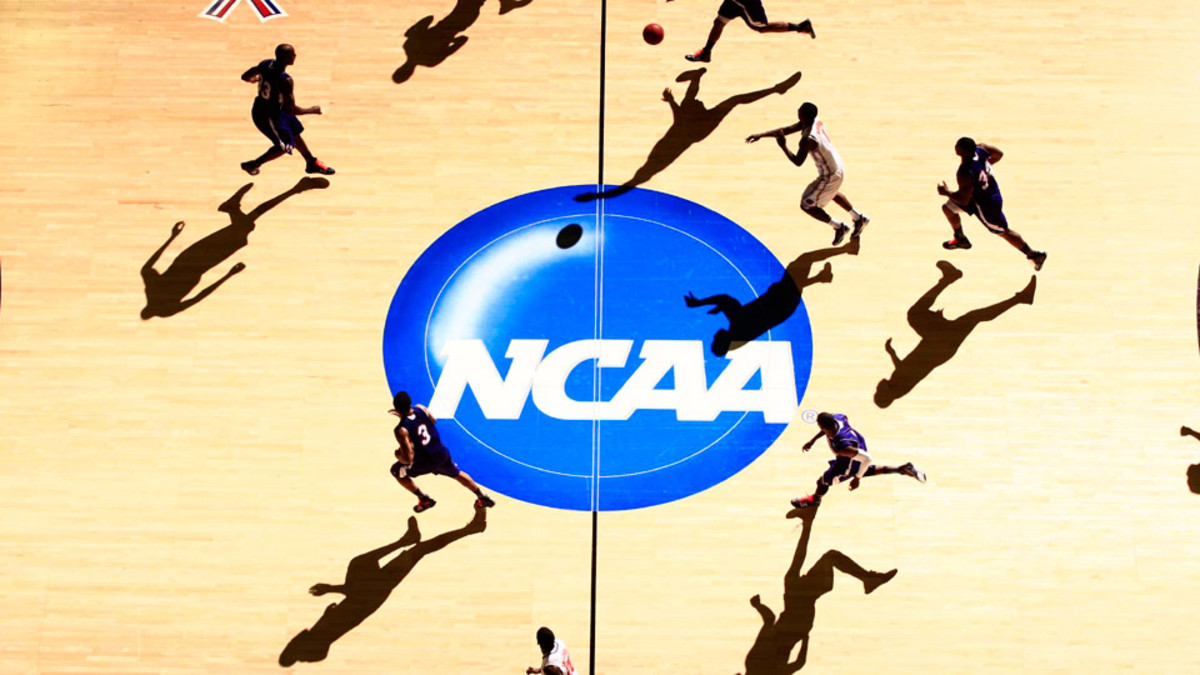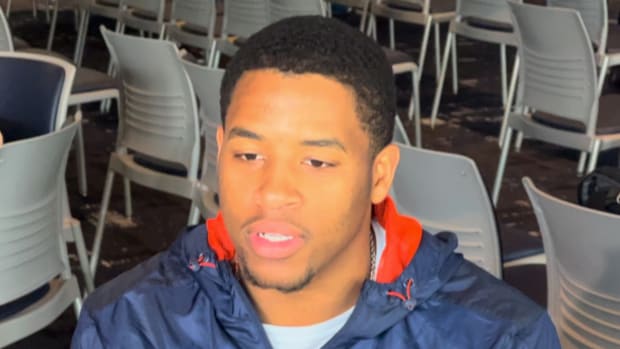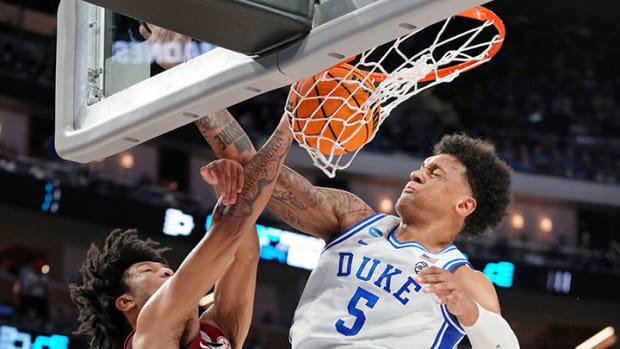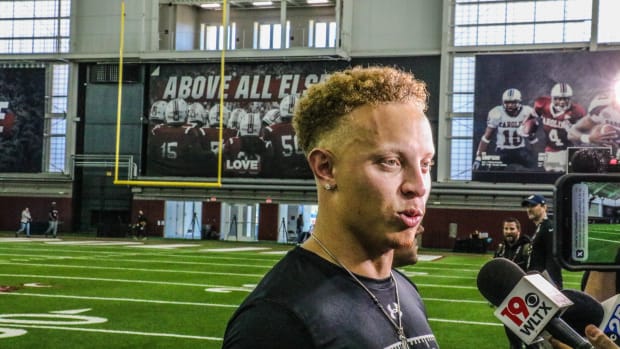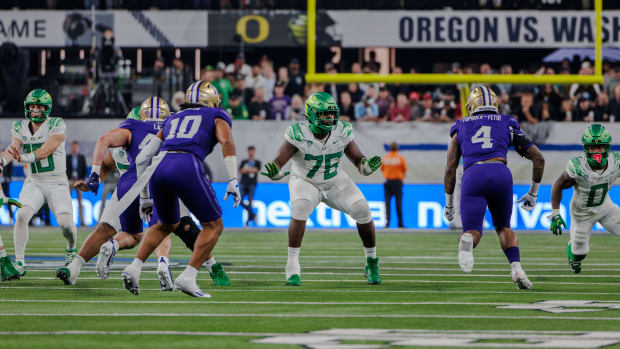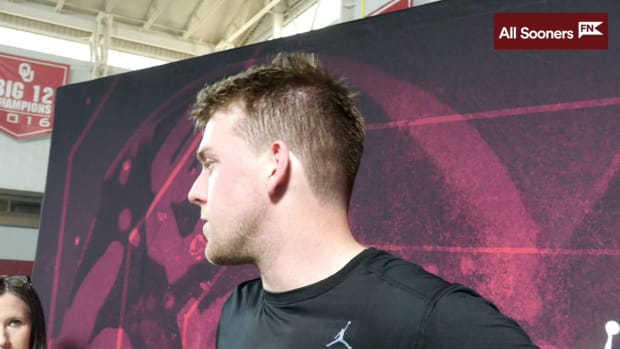How the NCAA botched its case in the landmark Ed O'Bannon antitrust trial
OAKLAND, Calif. -- It’s a good thing for the NCAA that I’m merely an interested observer at the landmark Ed O’Bannon antitrust trial, as opposed to the actual judge. Friday marks the final day of testimony in the three-week proceedings, and barring some 11th-hour epiphany from the NCAA’s remaining witnesses, I would most certainly rule in favor of the plaintiffs.
Mind you, unlike many anti-NCAA zealots out there either following or covering this case, I did not make up my mind before the trial began. I came to the courthouse fully open-minded to the prospect of either side winning me over. But I’ve been thoroughly unimpressed -- and, quite frankly, stupefied -- by the NCAA’s characteristically tone-deaf defense strategy.
While I had preexisting reservations about the use of football and men’s basketball players’ names, images and likenesses without proper compensation, the NCAA still could have convinced me of the necessity of preserving its traditional amateurism model. I don’t view student-athletes as exploited laborers toiling at the whim of deep-pocketed, power-hungry overlords. Having spent considerable time on various campuses interviewing coaches, players and administrators, I generally hold positive feelings about the people who devote their lives to college athletics. Sure, some coaches and athletic directors are getting rich. But for most parties -- compliance officers, strength and conditioning coaches, video coordinators and more -- theirs is a labor of love.
Yet over three weeks of testimony, the NCAA’s 14 handpicked witnesses to date have mostly pontificated the type of elitist, ivory-tower rhetoric that routinely infuriates its critics. It has offered little convincing evidence that compensating athletes through group licensing fees would irreparably harm college athletics. And that’s coming from someone like me, who passionately enjoys college football and basketball. I can’t imagine the organization has fared better with U.S. District Judge Claudia Wilken, for whom the sports world is so spectacularly foreign that she had to ask one witness to spell out ESPY.
SI.com's O'Bannon v. NCAA coverage
In a trial, attorneys collaborate with clients to tell the most flattering possible version of their story. For the NCAA, that should have entailed painting a picture for Wilken of a noble-minded enterprise in which thousands of young men -- many from disadvantaged families who couldn’t afford college otherwise -- leverage their athletic talents into life-changing opportunities, preparing for careers after sports and forming lasting bonds within a community. Certainly, there are highly publicized instances of abuse (booster Nevin Shapiro at Miami) and farcical academics (North Carolina), but attorneys presumably would dismiss those as exceptions, emphasizing success stories as the norm. They would then show why allowing athletes to commercialize would tarnish the entire endeavor.
Instead, after the plaintiffs spent most of the first week laying out their various antitrust allegations, the defense has spent most of the subsequent two weeks trotting out an army of insular and tunnel-minded administrators conditioned not so much to combat threats to the athletes as much as those to their bottom line.
Witnesses have included the NCAA’s president (Mark Emmert) and a couple of his senior executives (Diane Dickman and Mark Lewis, who will testify on Friday); conference commissioners (the Big Ten’s Jim Delany and Conference USA’s Britton Banowsky); a university president (South Carolina’s Harris Pastides); athletic directors (Stanford’s Bernard Muir and Texas women’s AD Chris Plonsky); and the requisite economic and academic types.
Astonishingly, an organization that tells us to think of it as “a marching band celebrating student-athletes in everything they do” did not call a single … wait for it … student-athlete. Two of the NCAA’s four pre-competitive justifications for prohibiting compensation are that consumer demand of college sports is dependent on maintaining amateurism and that amateurism rules promote an integration of academics and athletics. Who could possibly be more qualified to speak to the merits of amateurism than a successful former amateur athlete?
Three of the plaintiffs’ nine witnesses were former athletes, all named plaintiffs in the case: former UCLA basketball star O’Bannon, former Alabama wide receiver Tyrone Prothro and recent Vanderbilt linebacker Chase Garnham (who was a current athlete at the time he joined the suit). The NCAA’s lawyers did cross-examine them, which elicited a few fond memories from their respective careers. But mostly the three advocated against the NCAA model; after all, they signed on to the suit because they want to see the system change.
There is no shortage of disgruntled former college players, but there are surely as many -- and likely more -- who cherish their college experience and could care less about the use of their names, images and likenesses. For example, take star Oregon quarterback Marcus Mariota, who recently told CBSSports.com: “I just feel blessed” to play college football.
“They're talking about paying college athletes,” Mariota said. “Looking behind me, these facilities. The resources we get around here. We'll never get this much help in our entire life."
Yet the NCAA didn’t deem it necessary to call a single individual who may have parlayed that support into success and could speak on its behalf.
In an interview during a break between proceedings on Wednesday, NCAA chief legal officer Donald Remy said “technical issues” played a factor in that decision. “We actually had a number of [current] student-athlete representatives that were prepared to testify,” he said. However, once Wilken certified any FBS football or Division I basketball player to appear in game footage since 2005 as a class-action plaintiff, Remy said court rules prohibited NCAA attorneys from contacting them. That ruled out someone like Mariota.
However, what about someone who played a little earlier than the period in question? Maybe former Xavier center David West, the 2003 AP Player of the Year who went from overlooked prep school recruit to college graduate and future NBA All-Star, would have made an impression on Wilken? I have no idea if the Indiana Pacers star would testify; it’s a hypothetical example. Still, he does play in the same city as the NCAA’s headquarters.
Remy seemed unconcerned about this ostensibly glaring absence because, you see, we did hear from some former athletes: late 1960s North Carolina point guard Jim Delany, late-‘70s Kent State basketball player Chris Plonsky and early-‘80s Tulsa golfer Diane Dickman. “They talked about their collegiate experiences quite fondly,” Remy said.
Here’s guessing Wilken found Delany’s Dean Smith stories slightly less relevant to the matter at hand than his more contemporary role negotiating the very billion-dollar TV contracts for which the plaintiffs are seeking a cut.
If not athletes, then what about the people who interact with them daily? Of the NCAA’s 15 witnesses (including Lewis), just two, Stanford’s Muir and Texas’ Plonsky, work in an athletic department.
Big Ten advocates new benefits for student-athletes, but is it too late?
The defense’s primary champion for its academics argument was Dickman, the NCAA’s director of academic and membership affairs. The NCAA absolutely cares about academics, she said, and proceeded to talk about her work crunching APR and GSR data. I’m sure Wilken came away a convert to the splendor and significance of a 955 APR score.
I might suggest a more compelling witness. Like, say, Margaret Akerstrom, who spent 26 years as the head academic advisor at my alma mater, Northwestern. When I interviewed her last year for my “Revenge of the Nerds” feature, she could still recall current Wildcats coach Pat Fitzgerald’s freshman coursework from 20 years earlier, and she spoke fondly of all the former athletes she helped transform from wide-eyed freshmen into accomplished adults. Think her stories might resonate better with a judge than Dickman’s hazy numbers?
And not a single college coach? In a trial about college sports? Really?
One after another, NCAA witnesses have prophesied about an unsavory future in which, if the plaintiffs prevail, recruits will choose their schools based primarily on which can offer the biggest paycheck. I think we can all agree that’s an undesirable potential outcome, but it is based entirely on theoretical predictions.
What about hearing from someone who actually recruits? Like TCU football coach Gary Patterson. Or Florida basketball coach Billy Donovan. Let them explain firsthand the challenge of convincing a sought-after 17-year-old to put his best long-term interests above witty Facebook messages or cute co-eds, and how the injection of money into the dynamic might lead to many more bad decisions.
It may be that none of this holds any bearing on Wilken’s decision. Ultimately, at its core, this is still largely a bone-dry antitrust case. Plaintiffs’ economic expert Roget Noll kicked things off back on June 9 by declaring the NCAA a “cartel that creates a price-fixing scheme among its members.” Seventeen days later, on Thursday, the NCAA’s counter-expert, Daniel Rubinfeld, began arguing that the organization is a much less ominous joint venture of its members whose shared restrictions benefit the college sports market as a whole. (Rubinfeld will retake the stand on Friday morning.) Wilken will weigh the two arguments before rendering a judgment, likely in early August.
It would be an enormous upset at this point if she ruled in favor of the NCAA.
Maybe the NCAA’s argument is a lost cause. Maybe this day was always coming. But after five years of litigation and many millions spent in billable hours, one would think the organization would have put up its best possible fight.
Instead, it wasted three weeks mostly trumpeting the same tired clichés its leaders routinely espouse for free in press conferences and at conventions. For that it deserves to lose. Why should a judge believe that college athletics is some sacred vehicle for education when its leaders never learned how to effectively tell a story?
